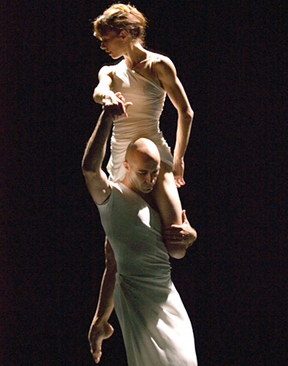Transcendence
"New Solo", "Transmission", "Push"
Russell Maliphant Company
Sadler's Wells Theatre
April 6 & 7, 2006
by John Percival
copyright ©2006, John Percival
 I'm sorry that Russell Maliphant took such a dislike to classical ballet.
I remember watching with pleasure when he danced solo parts with Sadler's
Wells Royal Ballet during most of the 1980s, but we learned that he didn't
enjoy it; he claims that he "never quite connected" with it, and "some of
the skipping about made me feel awkward and ridiculous". Ironic, then,
that his present fame has arisen through his collaboration with ballet
dancers: the "Ballet Boyz" (William Trevitt and Michael Nunn, formerly of
the Royal Ballet before starting their own company), and then Sylvie
Guillem. In the meantime, Maliphant worked with quite a few of our modern
choreographers, but it appears that the one who most crucially affected him
was Laurie Booth, with whom he experienced the American-influenced practice
of "contact improvisation". The excitement of that provoked him into
starting choreography, and gradually building up a style of his own which
attracted the stars already mentioned. As a consequence, he has graduated
from small audiences in studio theatres to sold-out performances at Sadler's
Wells, where he has just presente d his third programme in two years, this
time created for a new company, all recently recruited.
I'm sorry that Russell Maliphant took such a dislike to classical ballet.
I remember watching with pleasure when he danced solo parts with Sadler's
Wells Royal Ballet during most of the 1980s, but we learned that he didn't
enjoy it; he claims that he "never quite connected" with it, and "some of
the skipping about made me feel awkward and ridiculous". Ironic, then,
that his present fame has arisen through his collaboration with ballet
dancers: the "Ballet Boyz" (William Trevitt and Michael Nunn, formerly of
the Royal Ballet before starting their own company), and then Sylvie
Guillem. In the meantime, Maliphant worked with quite a few of our modern
choreographers, but it appears that the one who most crucially affected him
was Laurie Booth, with whom he experienced the American-influenced practice
of "contact improvisation". The excitement of that provoked him into
starting choreography, and gradually building up a style of his own which
attracted the stars already mentioned. As a consequence, he has graduated
from small audiences in studio theatres to sold-out performances at Sadler's
Wells, where he has just presente d his third programme in two years, this
time created for a new company, all recently recruited.
Most impressively he showcases a very fine male dancer, Alexander Varona: tall, slender beneath broad shoulders, with a long face and shaven head, and possessed of a powerful stage presence. Born and trained in Cuba, he has wide experience there and around the world as dancer, choreographer and teacher. The dance Maliphant has made for him, billed simply as "New Solo" (surely not to distinguish it from the "Solo" he devised for Guillem?), reveals an astonishing fluency of movement. Reminiscent to some extent of Maliphant's own dancing, with its sculptural patterns and cool control, it develops from the quiet but strong stretchings that open it into increasingly forceful but always calm turns around the stage.
Varona also dances, with Julie Guibert from France, a reworking of the highly unusual duet "Push" which Maliphant made last year for Guillem and himself with its repeated quiet lifts, descents and involved confrontations. You would not expect the new cast to match the remarkable weight of movement and meaning which the original couple provided, but even in this less compelling form the piece still keeps its interest.
Guibert is, besides, one of the five women who dance the programme's centre-piece, "Transmission". Two of the others come from Italy, one from Japan, and the only one born in England is described as having English-French nationality and training in London, Cannes and Rotterdam. Well, somehow Maliphant and his rehearsal director Ellen van Schuylenburch (Dutch born, experienced in the USA and Britain) have instilled a coherent approach into this disparate ensemble. In the opening section we see only four dancers' hands or arms picked out of darkness by Michael Hulls's lighting, then the start of sudden swift solo movement on the floor, or pairs of bodies making slow upright patterns, comes as a contrast. Curiously, this dance feels long and "Push" seems short, although both of them last 35 minutes. One problem for me with "Transmission" is the incoherent soundtrack by mukul, who is described as playing with various media, particularly sound and text, to explore relationships between rule-bound forms (both classical and novel) and chance, between technology and tradition, and between signal/data/music and noise. Yes, well. Luckily the movement Maliphant offers has an interest that transcends its accompaniment.
Photo, of Sylvie Guillem and Russell Maliphant from an earlier show, by Johan Persson.
Volume 4, No. 15
April 17, 2006
copyright ©2006 John Percival
www.danceviewtimes.com